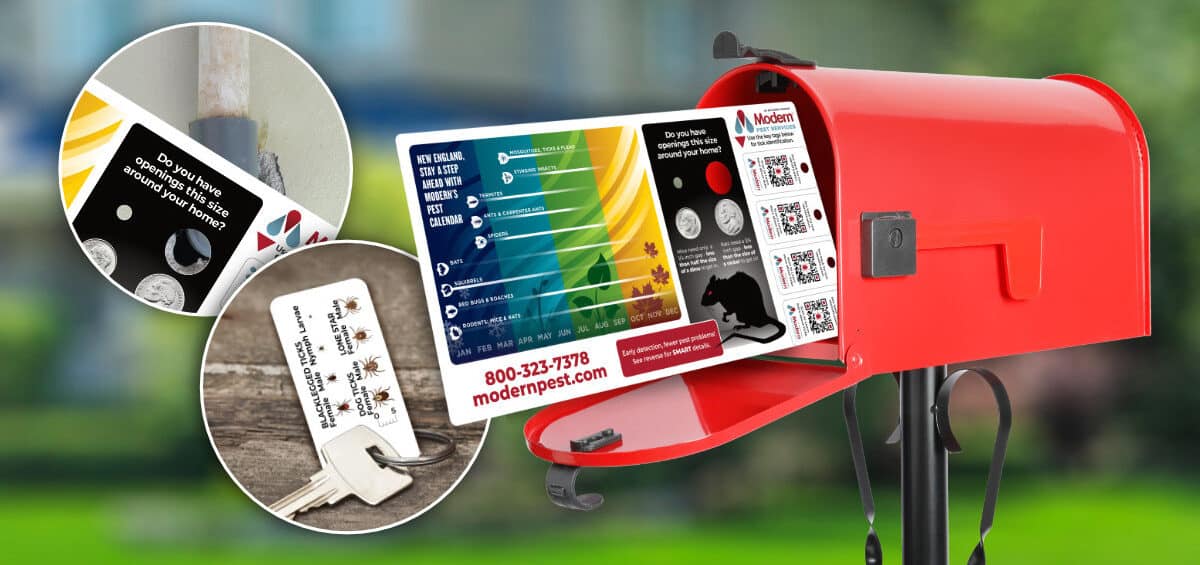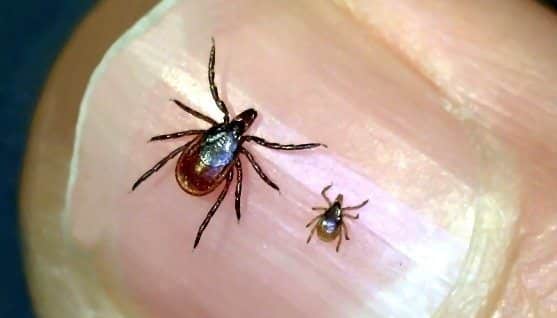
Modern’s complementary Pest Defense Calendar is now available to order online! This handy card offers several different features:
- Modern’s New England Pest Calendar, which allows you to be aware of the current pest pressures affecting the region month-by-month.
- Keychain hangers that provide information about ticks commonly found in Modern’s service area
- Holes that demonstrate the smallest gaps necessary for mice and rats to access a property. This measuring tool lets home and business owners quickly and easily measure any existing interior and exterior spaces that might be large enough for rodents to use as an access point.
To order your own card, just fill out the form. To schedule service, call 800-323-7378
Explore Our Handy Pest Calendar
Discover how pests affect New England homeowners year-round. Complete the form and receive your FREE comprehensive pest calendar. Equipping yourself with knowledge about pests and engaging in year-long pest control with Modern can prevent home infestations.
Pests are a year-round issue. Stay up-to-date by downloading our complimentary Pest Calendar. Click here!
Spring
Spring heralds a resurgence in New England as bugs emerge across Maine, New Hampshire, Massachusetts, Connecticut, and Rhode Island. Insects relish the spring weather, awakening from hibernation during winter months to appear once again. They thrive in the warm climate, rain, blooming flowers, and abundant food sources.
It’s easier to identify various pests more effectively with increased knowledge. For example, mosquitoes lay eggs in standing water, while termite swarms signal potential issues. Stinging insects like yellow jackets and wasps congregate around blossoms.
Common sightings include termites, ants, flies, mosquitoes, spiders, earwigs, and stinging insects like wasps and hornets.
Summer
Continued warm weather in New England fuels insect activity. Humans and pets, relishing the outdoors, become targets for pests seeking a blood meal. Summer travel enhances the prevalence of bed bugs, while birds and wildlife contribute to seasonal nuisances.
Be prepared to encounter fleas, ticks, mosquitoes, bats, carpenter ants, stinging insects, termites, bed bugs, and flies.
Fall
Welcomed for its relief from summer heat, fall introduces a new dynamic to New England. As temperatures drop and foliage changes, pests adjust their strategies. Creatures such as mice, rats, and raccoons seek shelter, food, and water, with homes becoming an attractive haven.
Expect to encounter rats and mice, stink bugs, spiders, and fleas.
Preventing infestations starts with denying pests entry. Seal entry points, secure food sources, and avoid storing firewood near your home. Maintain cleanliness by clearing leaf piles.
Winter
Despite the cold, snowy winters, pests persist in seeking refuge indoors. Damp areas are particularly inviting, so ensure dryness in spaces like bathrooms, kitchens, and basements.
Encounters may include cockroaches, rodents, stink bugs, ladybugs, and silverfish.
Safeguard your home by maintaining a pest-free environment, removing potential food and water sources. Check holiday decorations for any unexpected pest hitchhikers and assess your home post-winter storms for new entry points.
The Dangers of Rodents in Your Home
Recognizing if rodents have entered your home is crucial. Once inside, animals can damage insulation, chew wires, and pose fire risks. Attic insulation serves as ideal nesting material for them, affecting your home’s heating and cooling efficiency. Damaged wiring poses significant dangers, potentially leading to house fires.
Attics often store valuable items like heirlooms, decorations, and clothing. Rodents can cause substantial damage to these irreplaceable or costly belongings, often going unnoticed until it’s too late.

Tips to Keep Mice and Rats Out of Your Home
- Remove items around the house that provide hiding spots for mice, such as firewood piles, stored patio furniture, and children’s toys.
- Trim back plants and trees that touch or hang over the structure.
- Inspect and replace damaged entry door bottoms, especially garage doors. Consider door sweeps designed to keep rodents out, available from Modern.
- Check all utility penetrations through exterior walls (electrical, gas, air conditioning lines) and seal openings with suitable materials like steel wool or copper mesh, avoiding expanding foam that rodents can chew through.
- Examine window and vent screens for holes and gaps, including crawl space vents. Repair as necessary.
- Seal gaps in siding, especially at corners, using appropriate materials.
- Any openings around the home larger than a dime should be sealed.
The Ticks of New England

New England hosts four common tick species: American dog ticks, brown dog ticks, black-legged (deer) ticks, and lone star ticks. Spring and summer pose the highest risk of tick bites, with infestations on the rise in recent years, presenting concerns for both pest professionals and homeowners. All four species carry risks for humans.
American Dog Tick
- Description: Typically reddish-brown with gray and silver markings on dorsal shields. Unfed females are around 5 mm long, slightly larger than males (about 3.6 mm). Engorged females can enlarge up to 15 mm long and 10 mm wide.
- Diseases: Tularemia and Rocky Mountain spotted fever are possible, exhibiting symptoms like skin ulcers and swollen glands.
Brown Dog Tick
- Description: Reddish-brown, lacking ornamentation. When fully fed, the body changes to a more blue-gray. Sizes range from 1/8 to 3/16 inches.
- Diseases: Known for transmitting Rocky Mountain spotted fever.
Black-legged (Deer) Tick
- Description: Identified by black legs, pale body color, tear-drop shape (females), and round dorsal plate (males).
- Diseases: Carries Lyme disease, anaplasmosis, ehrlichiosis, babesiosis, and Powassan disease.
Lone Star Tick
- Description: Named for the single white spot on adult females’ backs. Females are about 1/4 inch long, growing larger when engorged.
- Diseases: Linked to diseases like Ehrlichiosis, Tularemia, STARI, and alpha-gal allergy.
DIY vs. Professional Pest Control
While DIY pest control may seem tempting, it can pose hazards. Unprepared attempts might cause physical harm, property damage, or even fires. The trained professionals at Modern understand the risks and have years of experience in the field.
How Modern Can Help
Modern Pest offers solutions for various pest issues in New England homes. Programs like Homecare Green protect against over 55 common household pests, including mice, rats, stinging insects, carpenter ants, and cockroaches. Homecare Mosquito, Flea, and Tick service guards against all three disease-carrying pests.
Additionally, Modern offer Anticimex SMART technology, an intelligent and eco-friendly pest monitoring system. If activity is detected, SMART communicates with Modern offices for swift action by our Pest Service Professionals.
Benefits include:
- 24/7 home monitoring with SMART technology.
- Pest removal and setup by service professionals.
- Environmentally safe solutions.
Contact Modern at 800-323-7378 for more information or to schedule service.
